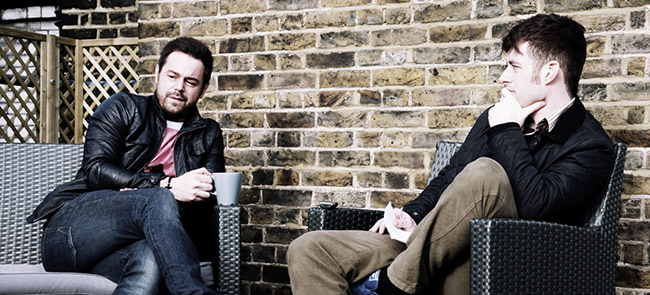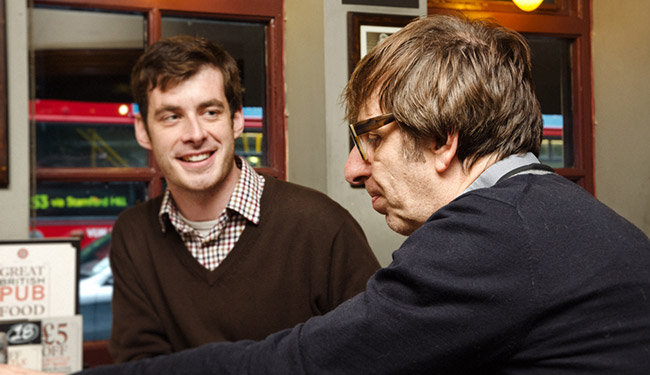For the past few months Heart Internet has sponsored the Arrest all Mimics Podcast, put together by Channel 4, The Guardian, WWE and The Premier League illustrator Ben Tallon.
The series features in depth interviews with designers, artists and illustrators. From Adidas designer Peter O’Toole to Illustrator Rod Hunt, Ben is bringing the creative life to a wider audience.
“The point”, says Ben, “is that creative activities are playing an increasingly more important role in society. They have the potential to channel emotions and feelings. Art and design can help you think laterally, adapt quickly to new situations, solve problems and find a real sense of purpose and belonging. I want more people to experience that”.
I caught up recently with Ben to find out more about his background and experiences.

How did you get started in illustration and design?
I always had a passion for drawing. At school it was all I really cared about, aside from sport.
I got a place at Bradford College studying Graphic Media Communication, but to be honest I didn’t really have a clue what the course was about. Once it started I found the topics were wide ranging, giving you a taster of many creative disciplines.
I discovered that it was possible to do a course solely in illustration. And I found one at the University of Central Lancashire (UCLAN). I didn’t look back.
So you went straight from there into a job in illustration?
No: leaving UCLAN I ran into a common problem for designers. I didn’t have a track record, and people only wanted to hire those with form. But without getting a break, how could I prove I could was up to the job?
I spent a couple of years temping. One of the most interesting jobs was part of the recycling team at Preston city council. And that’s when the illustration started to get going.
We campaigned to get more people recycling. Some of that involved generating print work, and I volunteered for it. Before long I was being asked to do illustrations and design. I realized I might be onto something.
It inspired me. A small group of us with similar interests hired a local garage so we’d have space for our creative work outside of the 9 to 5. I created a portfolio good enough to start showing to those who might commission work.
But still I lacked experience, so I really needed to prove my ability.
I always had a thirst for football. There were plenty of football magazines. I used to follow the week’s footballing news and then produce a relevant illustration, and send it in speculatively to ‘When Saturday Comes’.
I also tried The Guardian. I’d take an article they’d run, cut it up roughly and then add my illustrations. It was a great way of showing how I could make their words come to life.
It wasn’t easy, but before too long I was getting regular commissions.
So you’ve always stuck with magazine based illustration and design?
By no means. I’ve made a real effort to diversify away from news and magazine print. Those industries have had a tough 15 years and that’s been reflected in the dwindling budget they have for illustration.
I’ve always been open to meeting new people, for trying new things and getting involved with new projects. Customers have recommended me to others, and over time the projects that I’ve been involved with have morphed away from print.
These days I’m as likely to be doing set design, animation, story-boarding, online campaigns. There’s even been some live ‘art’ in the form of painting on products in-store as a PR stunt!
This means I’m more likely to be part of a team of designers, developers and animators. It’s through these that I’ve learned how illustration and design can be delivered through many different mediums.
How were you able to pick up those new skills?
I’ve never liked standing still. I knew I didn’t want to rely on print. I always wanted to move on and try new things.
Working with people from other disciplines has helped me learn their trade. For example, in doing the artwork of Channel Four’s Skins I learned from the animator how to adapt my work to other formats.
I’ve focused on building strong relationships with my contacts and colleagues. I never miss an opportunity to spend a bit of time in the pub with them – it’s always time well invested.
I call it Extreme networking. But not in a dry, business sense. It’s about really connecting with people, and being easy to work with.
I’m a big believer in good people skills. Let’s take email for example. When you’re pitching or working with others it’s important to structure your mails so they’re easy to read and make a simple message.
It’s a point I make to students who ask me to look at their work, who are trying to get their toe in the door.
It’s important to designers, and in fact anyone in the creative fields, to be able to interact with successfully with others. In many ways it’s better to focus on that, rather than endlessly polishing your craft.

Who was the best client you’ve worked with so far?
It has to be World Wrestling Entertainment (WWE), just for the sheer ‘other world’ experience. I’ve been lucky enough to work with them for the best part of a decade. I never get over the larger than life nature of landing a dream client in New York.
I recently designed a load of backdrops for some characters called ‘heels’ – the bad guys. I did the artwork and Fedex’d it to The States. The following week, the piece of artwork that had come to life in my studio was in all the wrestling magazines. It felt great.
The work I’m most proud of was for a charity called ‘CALM’ (Campaign Against Living Miserably), dedicated to preventing male suicide, the biggest killer of young men in the UK. I got involved because I’ve always believed that creativity allows people to guide their thoughts, to make sense of tumultuous feelings. It can realise benefits and impact their whole life.
With no budget I pulled together a project to release a fundraising album.
I knocked on doors, pulled favours, sent out pleas. It led to songs being given for free by the Strokes and the Libertines. And I was lucky enough to interview Danny Dyer, Mick Foley, Ken Garland and Stephan Merchant.
For my part I got to Art Direct the whole thing. On a human rewarding level it totally blew my mind.
Are there any design trends that you’re seeing right now?
There’s been a big transition in the capability of software to deliver effects that short cut the creative process. From Instagram upwards, these tools can be great.
I think that’s fine for what it is. What frustrates is when these are used to produce soulless designs. When the design is too much about the effect, rather than the creative idea itself. In some cases there’s no shortcut to the best piece of work.
Who are your design heroes?
From the illustration world, Ralph Steadman is one, Quentin Blake another. Fascinating work and fascinating lives. Damon Albarn has been a motivator since my early teens.
I try to not be too inspired by the work of others though. There’s a great risk in copying. Mimicry ends in parody. That’s one of the principles behind the podcast.
Art should always be about our own ideas.
I really experienced this at college. I spent a long time producing designs that were on trend, but didn’t stand out. I’d forgotten why I had started out on the journey.
It was only when a friend said ‘Why don’t you draw any more, Ben?” that I realized how far I’d veered away from the things I like doing in pursuit of what was popular.
Why did you start the Arrest All Mimics Podcast?
I’m really invested in the idea of making art and design accessible to all. As I said earlier, I want others to discover that creative activities can be beneficial on so many levels. It helps you make sense of the world and your life. It helps you think differently and respond to life’s challenges.
I wanted to create a body of work that allowed a wider group of people to access the topic and each take their own thing away from it.
What have been your favourite interviews so far?
I had great fun at the DA&D festival grabbing interviews with organisers, entrants and attendees. It was hard work but incredibly satisfying to bring this amazing event to a wider audience.
The podcast works best when telling engaging stories that people can really connect with. I interviewed Cat Rose who runs a brand called The Creative Introvert. She demonstrated how naturally reticent artists can use technology to find a voice and to share their work.
What’s gone wrong?
My biggest blunder came when I interviewed Bruce Duckworth, next year’s organizer of the DA&D. I’d had a great day, captured loads of voices, and Bruce came right at the end.
The interview went brilliantly. He shared some real insight into the future of the event. It was only when I looked down at the mic that I realized it hadn’t been on… Luckily, Bruce was kind enough to give me a second outing that ended up even better.
What equipment do you need to start a podcast?
It’s really simple actually. There’s another artist here [at the studio] who advised me on the Mic and SD card. It set me back £200 but the quality is superb.
I bought GarageBand for the Mac, which was £4. After about 6 hours of tutorials on YouTube, I was off!
How do you distribute the podcast?
Through SoundCloud and iTunes. I opened a Pro account with SoundCloud, and it’s fantastic. You get really good analytics to help understand how people discover your podcast, and which parts are popular.
iTunes is free but it’s harder to get a feel of what’s working. I’m investigating better tools for keeping track of the important numbers.
How do you promote it?
Well as you know I am mad on networking. Wherever I go, what ever I do, I talk about my podcast. I’ve given out flyers and leaflets, and never miss an opportunity to spread the word.
I’ve been able to connect with about 70 design and illustration lecturers so I make sure they know all about it and are sharing with their students.
And I’m very active on social media. I push it out through Twitter, Instagram and LinkedIn, through the Arrest All Mimics brand and my personal one too.
Who would be your dream interview?
Damon Albarn without a shadow of a doubt. The transformation of his work from Blur to Gorillaz and beyond has coincided with changes in my own life. Jamie Hewlett is another who I hope to bag at some point.
What’s next for the show?
What I’m really into is the confluence of art, technology and business. The Google Art Project is fascinating and I want to look deeper at that.
I’m also interested in how artists and designers can protect their work from being ripped off. It’s one of the oldest subjects around, but the problems are as big as ever.

Many thanks to Ben for his time and insight.
Be sure to catch the latest Arrest All Mimics podcast. You can also follow Ben on Twitter and Instagram and see his illustration portfolio at illustrationweb.com/artists/BenTallon and his lettering/set design at illustrationweb.com/artists/TallonType.

Comments
Please remember that all comments are moderated and any links you paste in your comment will remain as plain text. If your comment looks like spam it will be deleted. We're looking forward to answering your questions and hearing your comments and opinions!